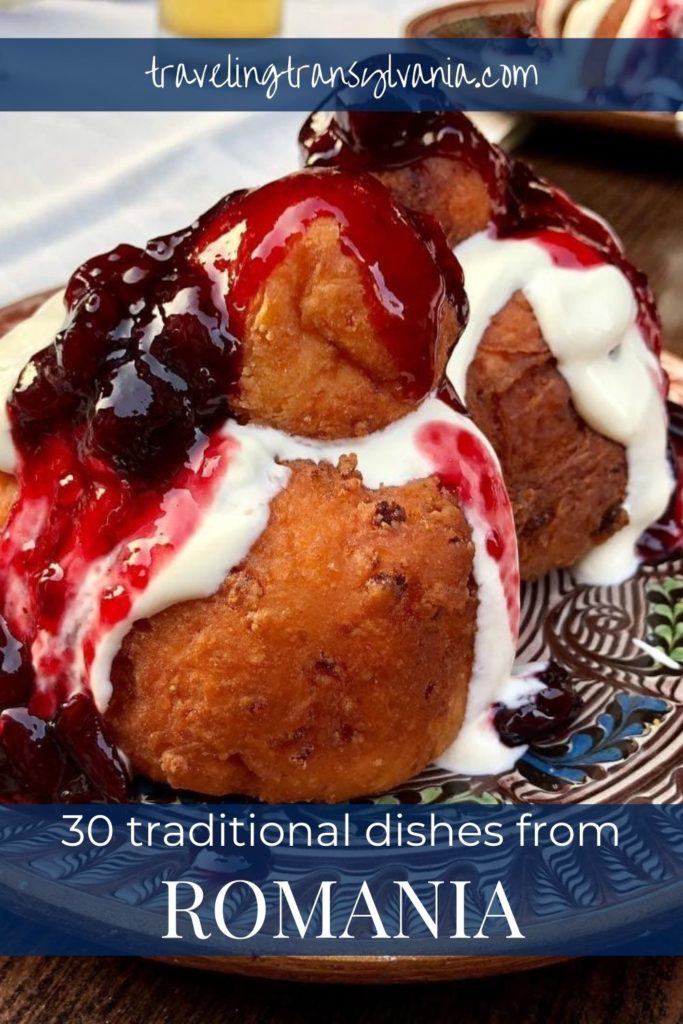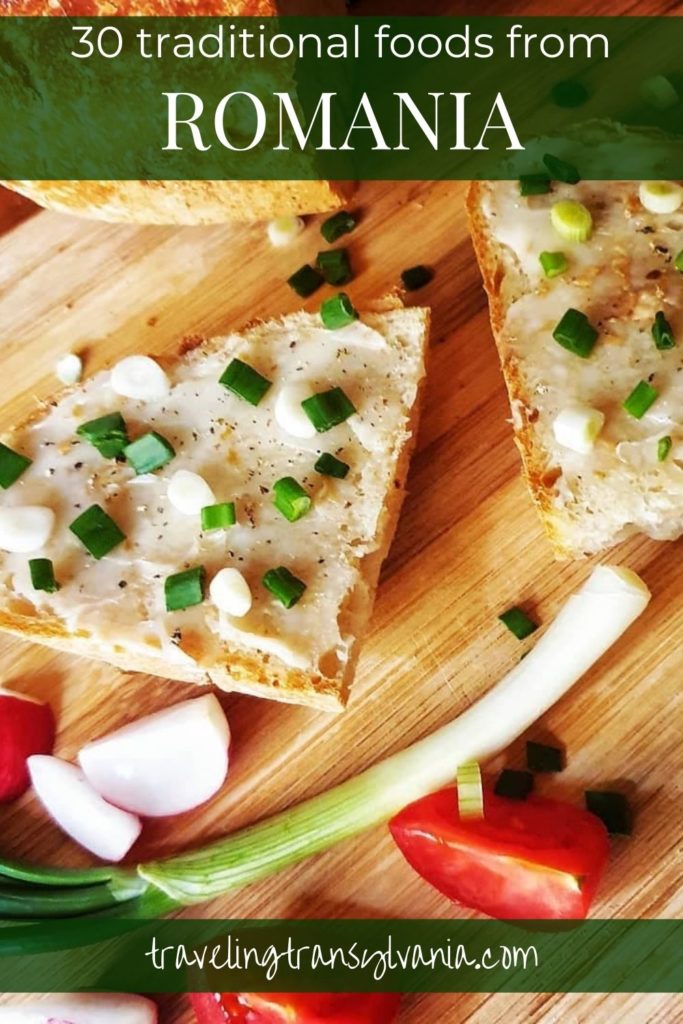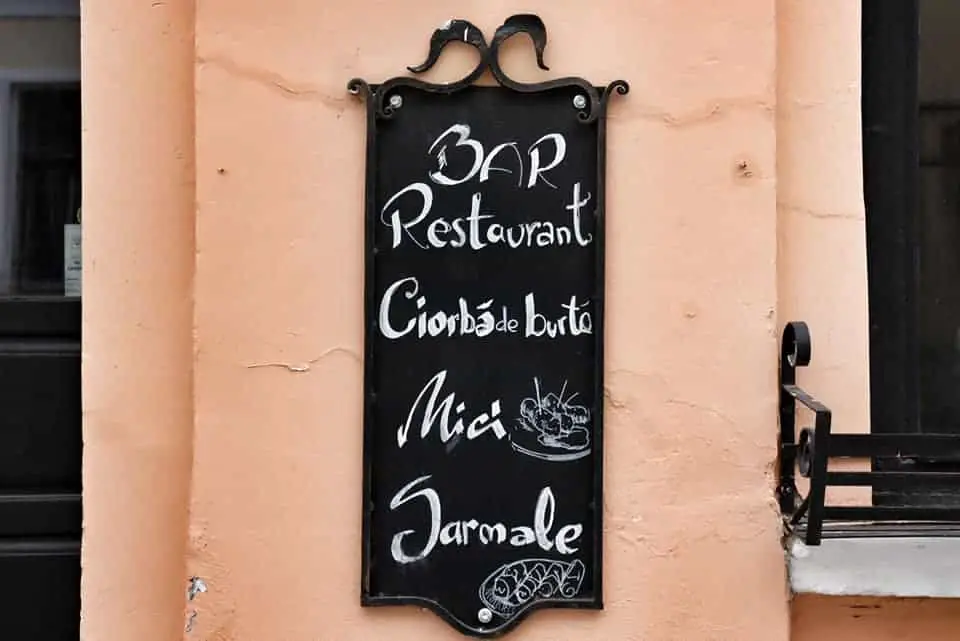This post may contain affiliate links. At no cost to you, purchases made through these links may result in a small commission for Traveling Transylvania. We never recommend products that we don’t know and trust. Thank you for your continued support!
There’s no way I could move to Romania and not write anything about the food! I had no idea what to expect for my first time trying traditional Romanian foods. I was not disappointed! Be sure to make sampling local cuisine one of your top things to do when visiting Transylvania. There are strong influences from outside regions, especially Hungary, which is something you should know before traveling to Transylvania. Wipe the drool from your mouth as you journey through these traditional Romanian foods to try – poftă bună!
- soups & snacks
- ciorbă de burtă – tripe soup
- transylvanian pork soup – ciorbă ardeleneasca de porc
- ciorbă de cartofi cu ciolan afumat – potato soup with smoked meat
- meatball soup – ciorbă de perișoare
- ciorbă radauteana – radauteana soup
- ciorba de ardei umpluti – stuffed pepper soup
- murături – pickles
- zacuscă
- salata de vinete – eggplant salad
- pită cu unsoare și ceapă – bread with lard and onion
- covrigi
- slănină
- main dishes
- holiday staples
- desserts
- vegetarian / vegan food in romania
- pin it
soups & snacks
ciorbă de burtă – tripe soup
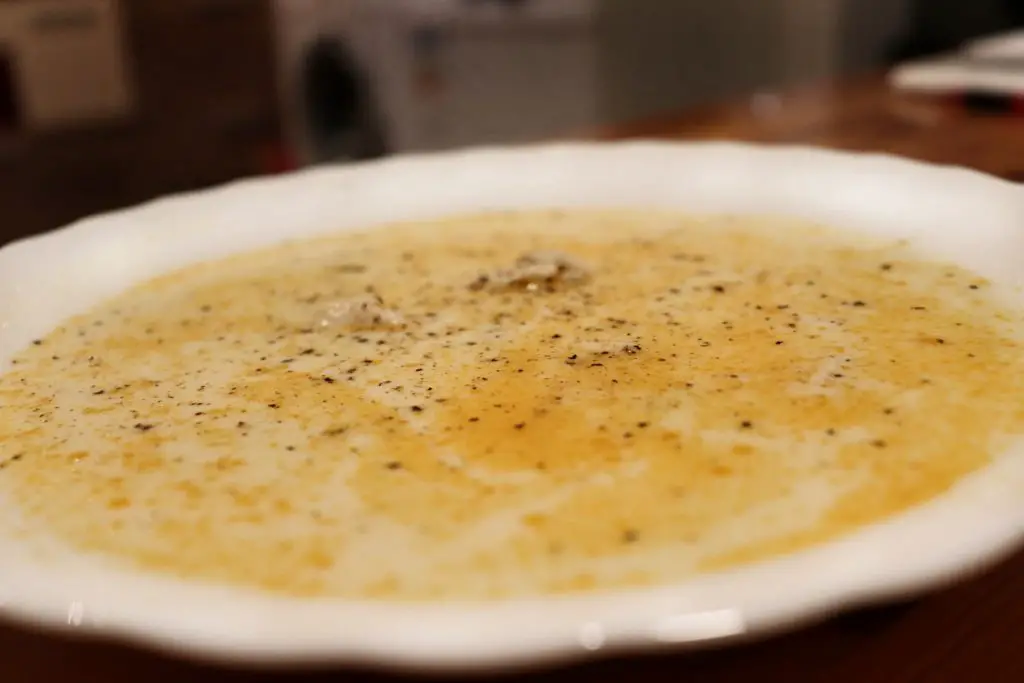
Ciorbă de Burtă (aka tripe or belly soup) is one of Romania’s most popular traditional dishes. This is without a doubt the most popular soup on any restaurant’s menu and a beloved favorite of Romanians. The starring ingredient is tripe, or, cow belly. I have not tried it – everyone raves about it, but…. I haven’t been brave enough yet. One day soon, though.
transylvanian pork soup – ciorbă ardeleneasca de porc
‘Ardeal‘ is the region of Transylvania in Romanian. When you see the word ‘Ardeleneasca‘ on a menu, it simply means ‘Transylvanian‘. Obviously any food with the word ‘Ardeal‘ in it must be a traditional Transylvanian food! This is a traditional Transylvanian pork soup. Enjoy with slices of warm bread and pickled hot peppers.
Soups are insanely popular in Romania, and if you’re visiting on a budget, it’s a filling option at a restaurant for lunch (plus, there’s bread!).
ciorbă de cartofi cu ciolan afumat – potato soup with smoked meat
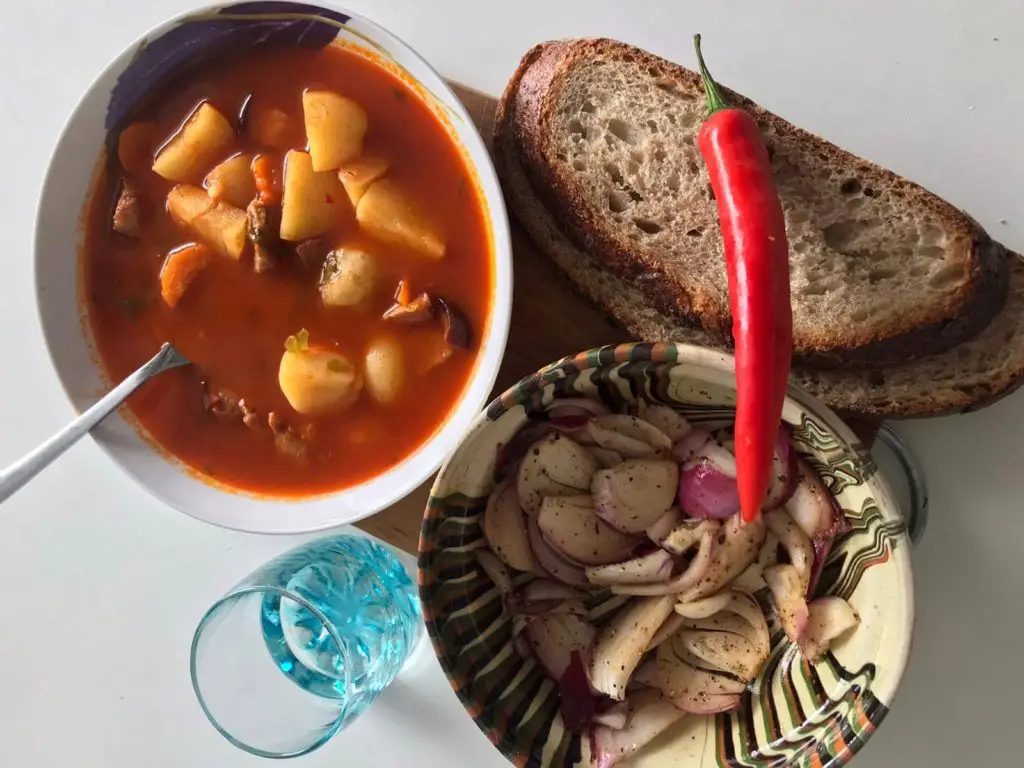
Really, any soup with ciolan afumat is popular in Romania, and the red onion salad that accompanies it is also very traditional. Enjoy the onions as a separate salad.
meatball soup – ciorbă de perișoare
Meatball soup is another of Romania’s famous ciorbe. It’s a staple on many restaurant menus. This is a traditional Romanian sour soup. The meatballs often made of ground pork mixed with some rice and spices, then boiled in the ciorbă.
It’s one of the most popular homemade staples of Romanian families. Soups are fairly simple to make, and can be done in large portions, making them a convenient dish.
ciorbă radauteana – radauteana soup
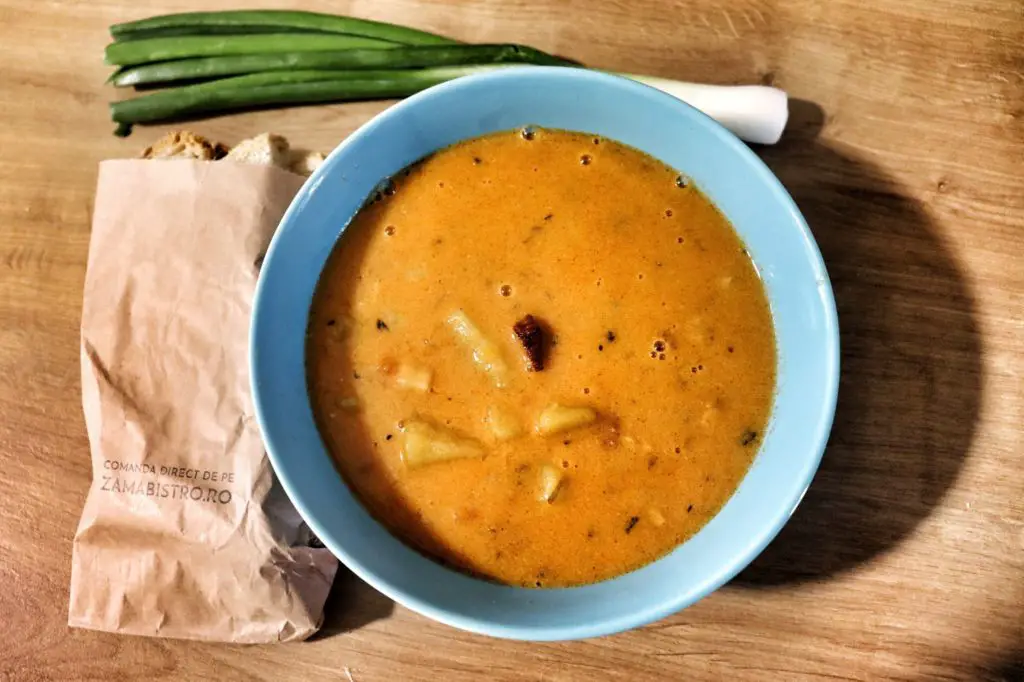
Ciorbă Radauteana was first introduced in 1979 in a restaurant in Radauti. Created by chef Cornelia Dumitrescu, she was trying to find an alternative for those who were not fans of Ciorbă de Burtă. She managed to create a lighter, cheaper (but very tasty) soup.
Turkey meat was the main ingredient in the original recipe. However, for economic reasons, Cornelia switched to the more inexpensive chicken.
ciorba de ardei umpluti – stuffed pepper soup
Stuffed pepper soup is a traditional Romanian cuisine not typically found in restaurants due to the fact that it isn’t easily pre-batched. Still, we would be remiss not to include it on this list of the best traditional Romanian dishes.
Especially nice for a cold winter night, this soup is perfect and filling. We have a great recipe with a couple of variations as well.
murături – pickles
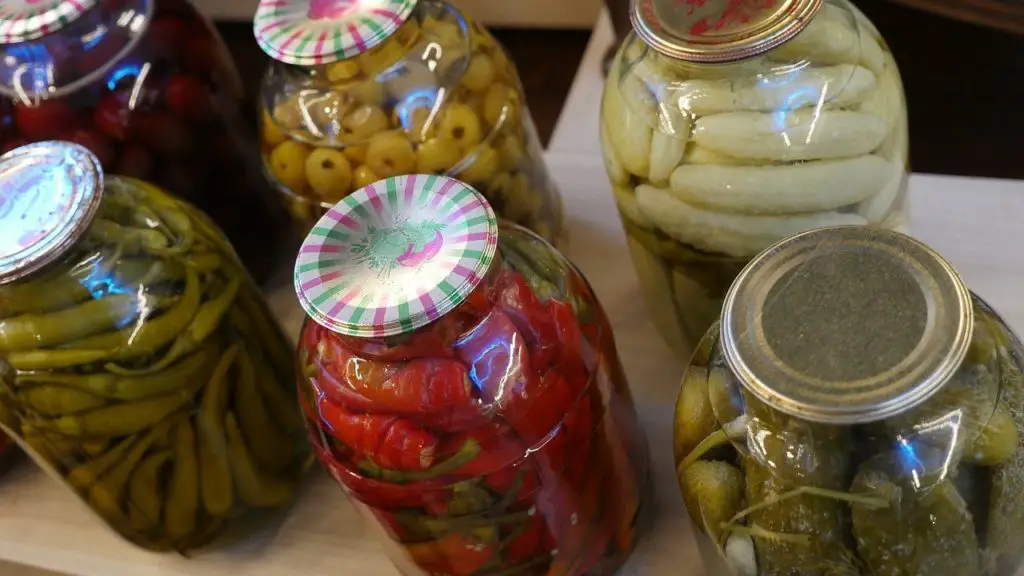
I absolutely love pickles. I don’t think I need to go any further, except to say, the pickles here are house-made, crunchy, and mouth-wateringly delicious.
The small assorted pickle salads you’ll find at restaurants are good, but nothing compares to the stuff you’ll find in a Transylvanian home – my mother-in-law’s pickles are TO-DIE-FOR!
zacuscă
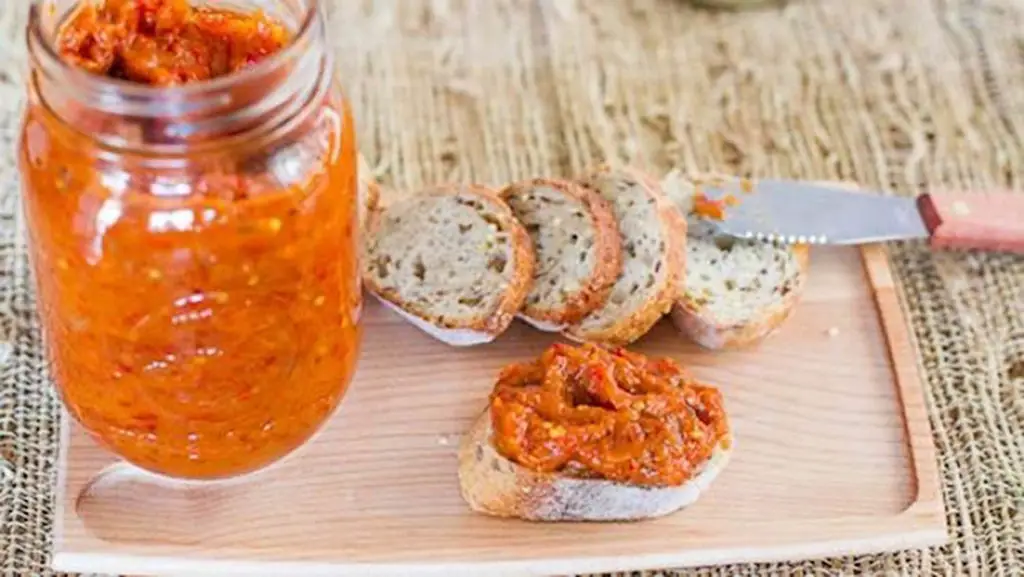
Zacuscă is an eggplant dip. It’s a great option for vegetarians or a cool summer appetizer. Its main ingredients are eggplant, onions, tomato paste, spices, and ‘paprika peppers’ (gogoșari in Romanian).
Many Transylvanian families will make this in the fall in large batches to last throughout the winter months.
salata de vinete – eggplant salad
Salata de Vinete is a traditional Romanian eggplant dip or salad. It’s delicious in the summer, with fresh bread, tomatoes and telemea cheese. Traditionally made with sunflower oil, diced onions, salt and lemon juice or vinegar. Lemons weren’t quite as popular in the past, so the original recipe called for vinegar. This is a must-have if you’re on a quest to sample traditional Romanian foods.
pită cu unsoare și ceapă – bread with lard and onion
This dish is a common appetizer on Transylvanian menus and one of the most old-school traditional Romanian foods. And simple, too – simply smear bread with pork fat and a sprinkle of chopped green onions. The richness of the bread and lard pairs quite nicely with the crispy, sharp bite of the onions.
covrigi
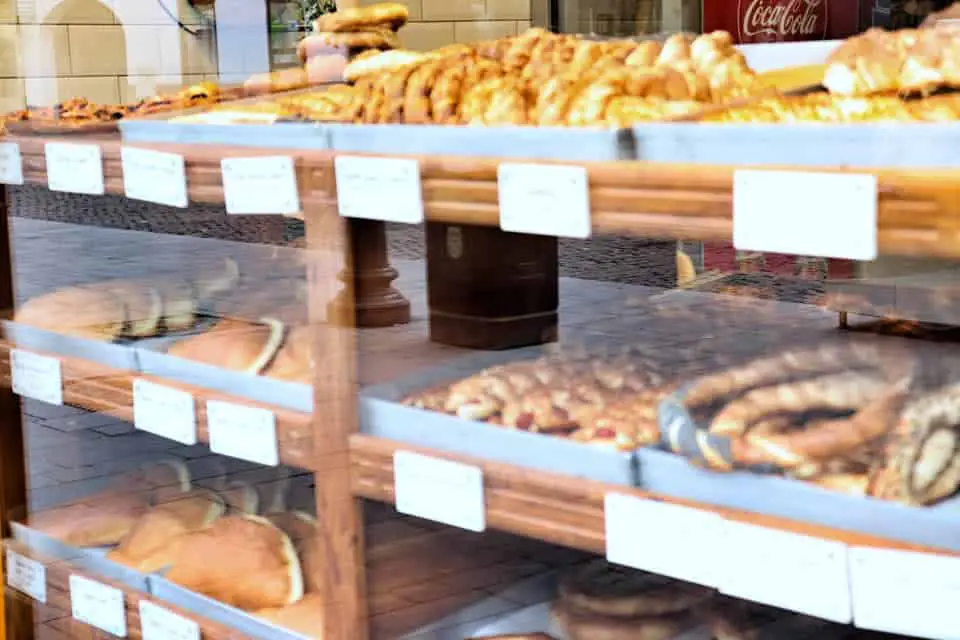
Covrigi are Romanian baked goods, similar to a pretzel. They come with a variety of toppings, and are easy to find at a walk-up window or bakery.
Visit the main tourist street of any major Transylvanian city, and you’re sure to find plenty of storefronts selling covrigi.
slănină
Slănină is essentially just a cured slab of fatback. It is most similar to Italian lardo, aside from the thickness. Slănină is very thick, whereas lardo is cut super-thin to pair with charcuterie.
The best way to try Slănină is to cut it into little batonnets (pictured above, far right) alongside freshly chopped (and salted) veggies, and torn pieces of crusty bread.
In restaurants, you’ll find Slănină on appetizer platters with other cured meats, local cheeses, and fresh produce. Slănină is among the most simple traditional Romanian foods.
main dishes
sarmale
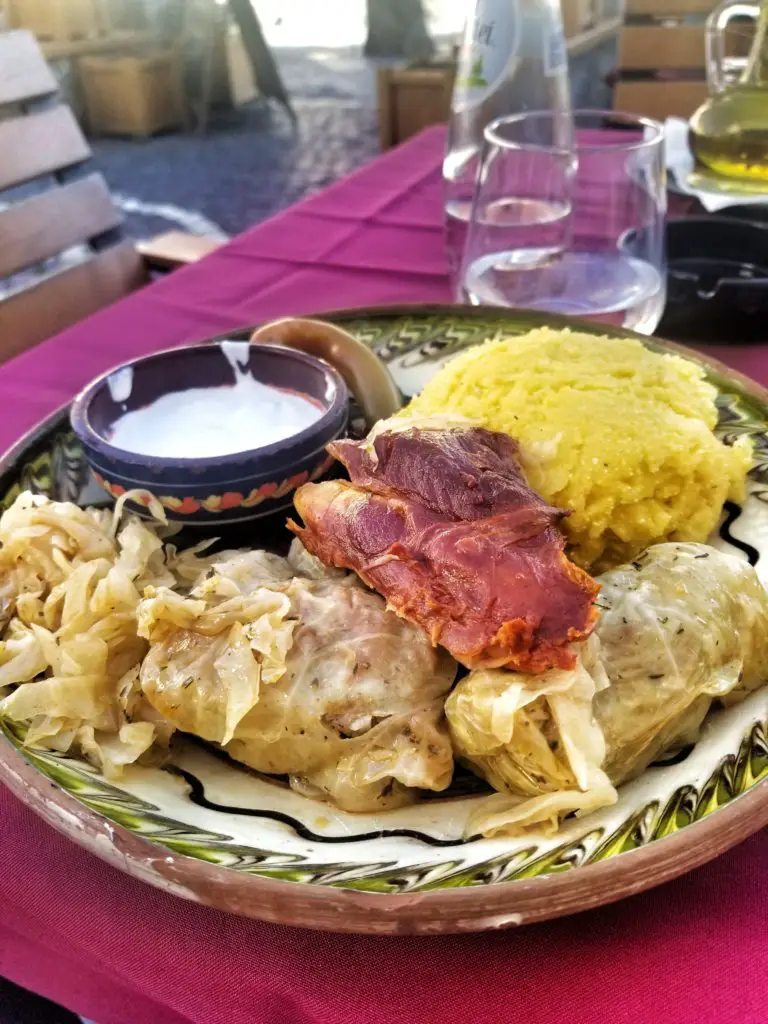
Sarmale is without a doubt the unofficial ‘official dish’ of Romania. Virtually every restaurant you visit that serves traditional Romanian food will have this staple on their menu. I had my first sarmale at La Turn, one of my favorite restaurants in Sibiu (pictured above).
Essentially stuffed cabbage rolls, sarmale can be stuffed with a variety of fillings, though a ground pork-rice mixture is often used. Served with polenta, cabbage, pickled hot pepper (and a few extra pieces of pork meat for good measure), sarmale is the ultimate Romanian comfort food.
varză a la cluj – cluj-style cabbage
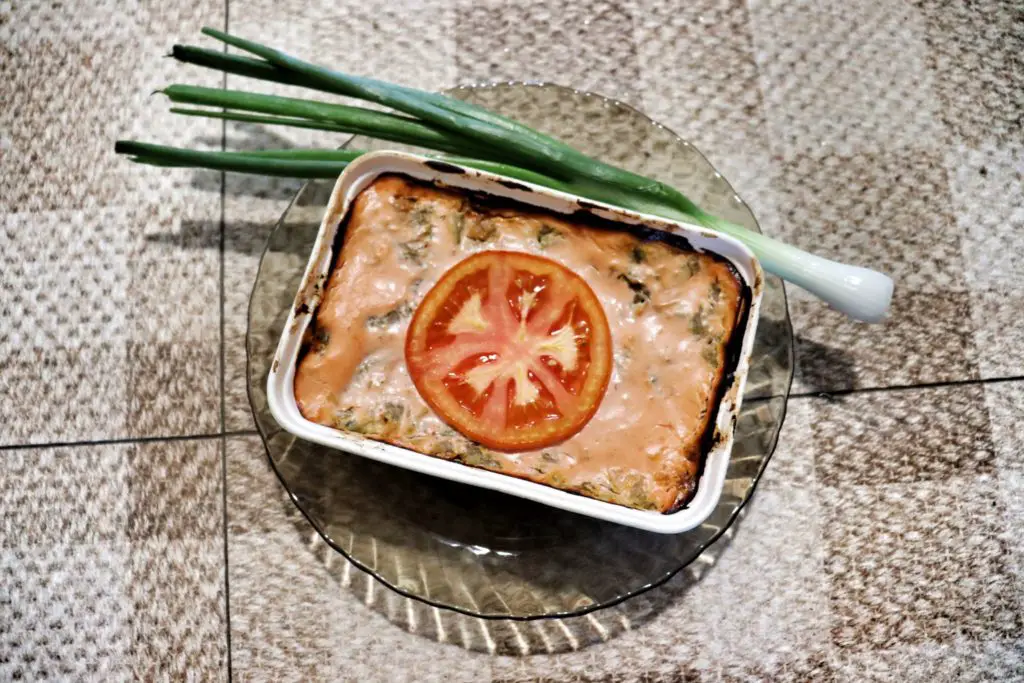
Cabbage is a staple in Romanian cuisine, and the city of Cluj-Napoca has its very own preparation. This traditional Transylvanian dish is made using minced meat, onion, cabbage, and rice and topped with a sour cream and milk mixture. As with any traditional Romanian fare, the specific recipe will vary greatly among families and restaurants alike.
papricaș de pui – chicken paprikash
Although this dish is of Hungarian origin, it’s typical to see on Romanian menus. This is particularly true in the region of Transylvania, where there is a large Hungarian population. The in-depth history is beyond the scope of this post, but you can read more about the connections between Hungary and Romania here.
Expect tender chicken simmered with vegetables, broth, and paprika with sour cream gradually folded in throughout the cooking process.
tocăniță
Tocăniță simply translates to ‘stew’ in Romanian, and is a very common preparation. Typically made with chicken or pork, other meats such as lamb can also be substituted. A common variation to the recipe is the addition of mushrooms. Pictured above is tocăniță with chicken and mushrooms – delicious! A great option for a cold or rainy day.
mititei (mici)
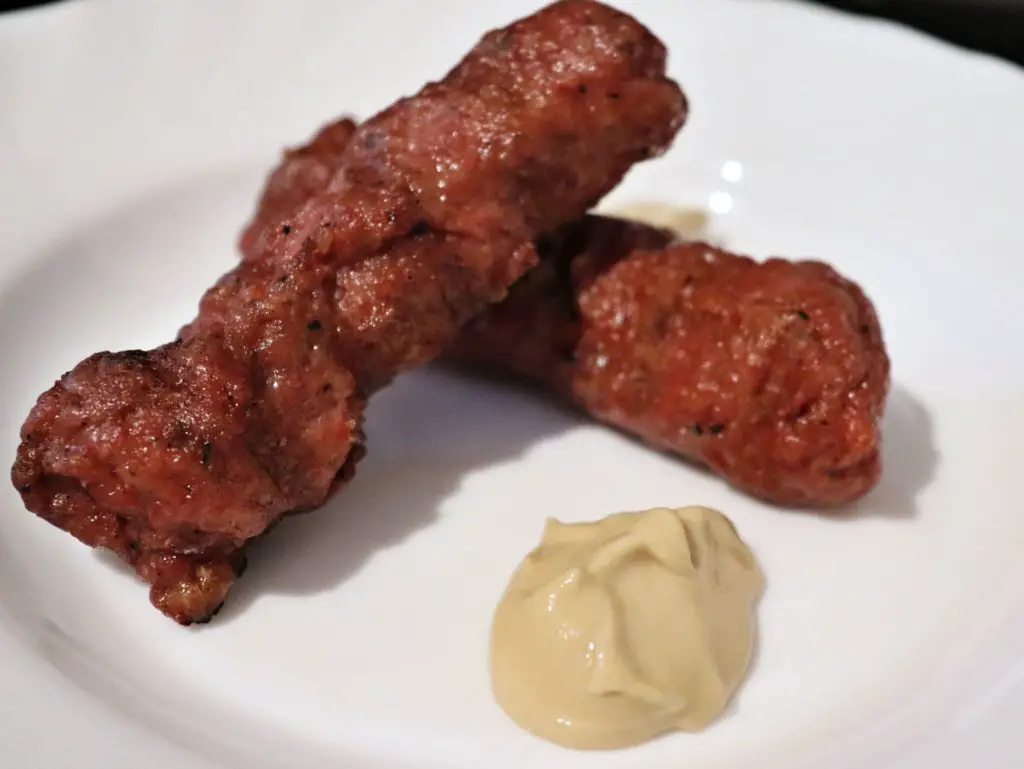
Affectionately known as ‘littles,’ you’ll find these guys everywhere, usually sold in portions of three. They are tiny, grilled ground meat rolls, usually a combination of different types of meat. It’s essentially a little sausage without casing.
Romanians love to have barbecues – as soon as warm weather arrives, your local friends will be inviting you to their backyard barbecues left and right. And ‘littles‘ are synonymous with outdoor grilling. Definitely in the top five of traditional Romanian foods to try.
coaste de porc – pork ribs
Pork is probably the most popular meat consumed in Romania. So, of course, menus all over the country have pork ribs. Different restaurants and families will prepare them differently, similar to ribs you’d eat elsewhere around the world. Still, who doesn’t love a good rack of ribs?
The best ribs I’ve eaten in Romania were at Rod Restaurant, one of the best restaurants in Cluj-Napoca.
mămăligă – polenta
Mămăligă is the Romanian word for polenta, a cheap and easy dish found worldwide. It’s a common side dish in Romania, accompanying tocănița or sarmale, among others.
There is a saying here: “Mămăliga nu explodează,” which conveys the message: Romanians are like polenta. Polenta doesn’t explode. It is amorphous, without guts, always adapting to whatever form is required.
bulz
Want to up your mămăligă game and have it as a main dish? Bulz is roasted polenta with cheese, sometimes with sour cream or an egg. It’s super-rich, definitely not even one bit healthy, and three bites will be too much. But if you’re a starving vegetarian, it might be a good choice for you.
tochitură ţărănească
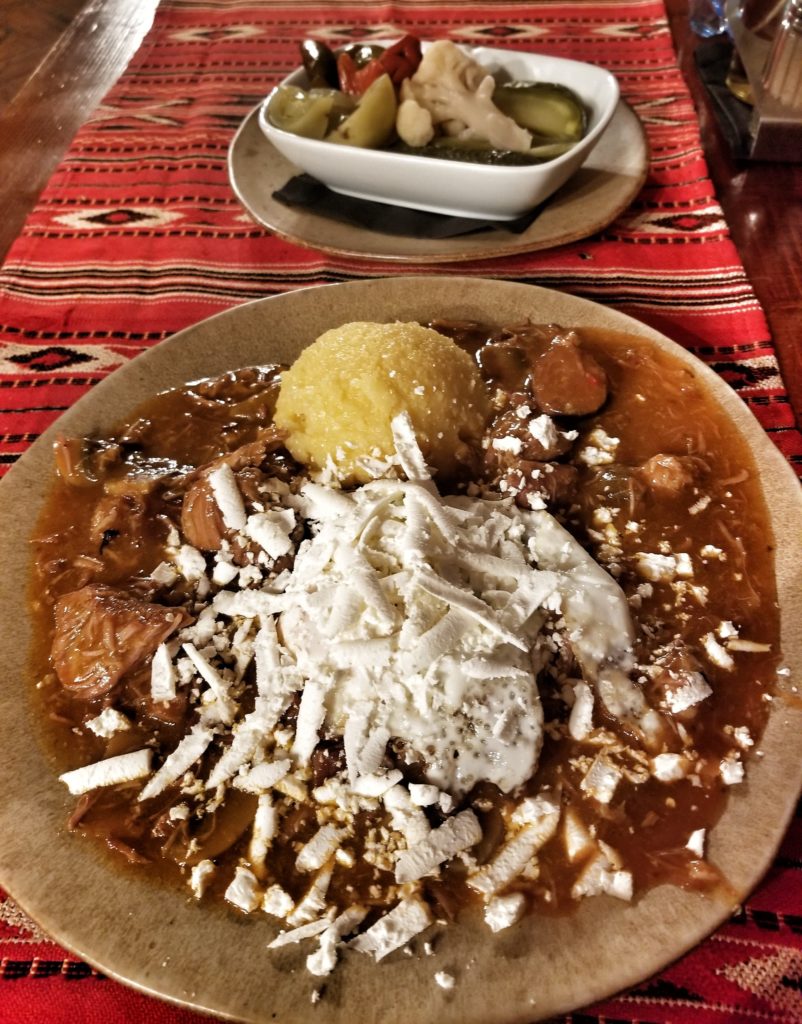
Tochitură is a traditional Romanian pork stew. It’s simmered over a low fire in its own fat and juices, most often in a cast-iron pot. It’s traditionally served with over-easy eggs and mămăligă.
Tochitură Țărănească means Peasant Tochitură, although you may often find a Moldavian version (Tochitură Moldovenească) and a Transylvanian version (Tochitură Ardelenească).
pizdulici la grătar
In all honesty, I’m not sure that pizdulici la grătar could be considered a traditional Romanian food (not many places have it because the cut of meat is rare), but it translates to ‘grilled pussies,’ so I had to at least mention it.
cașcaval pane – fried cheese
The Romanian mozzarella stick! Cașcaval pane is simply breaded, fried cașcaval cheese. It’s usually cut into triangles alongside fries or polenta. This one isn’t a personal favorite, but it’s on virtually every Transylvanian menu.
gulaş – goulash
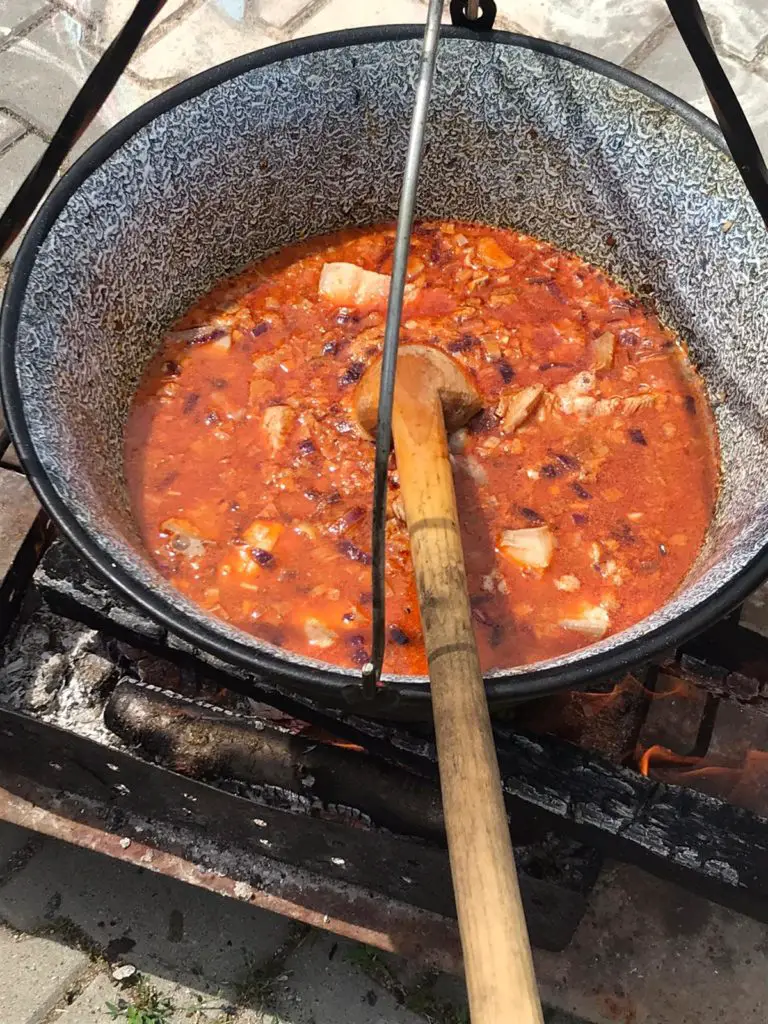
Another dish Hungarian in origin, but one that you will find on virtually every traditional Romanian restaurant’s menu. While it may not be made this way in a restaurant, if you’re eating at someone’s home, there’s a good chance it will be cooked in a ceaun (pictured above). A hearty meat and vegetable ‘soup,’ it is seasoned with paprika, among other spices.
The name gulyás is the Hungarian word for ‘herdsman,’ stemming from the dish’s history. The history of gulyás goes all the way back to the 9th century, when Hungarian shepherds would dry meat in the sun, pack into bags made of sheep’s stomach, and then add water to make it a meal.
The earliest versions of gulyás did not contain paprika, as this spice wasn’t present in the region until the 16th century. That’s right – the peppers used to make paprika are actually native to North America (Mexico, to be precise).
holiday staples
drob
Drob is a traditional Romanian food that is served at Easter. It’s essentially a meatloaf consisting of lamb organs (liver, kidneys, spleen, lungs, heart), eggs, green onion, and soaked bread. Some spices are incorporated, and then the membrane that contains the lamb’s organs gets placed over a pan and filled with the mixture.
red eggs
The red eggs of Orthodox Easter have many purposes during this holiday season. On the Thursday before Easter (aka Holy Thursday), people gather to boil and dye the eggs. They are traditionally dyed red to symbolize Jesus’ blood when he was crucified. Usually, particularly in villages, the dye consists of natural agents such as red onion skin or beetroot.
Before eating the eggs, it is customary for two people to knock their eggs together. While knocking them together, one person says “Christ is risen” while the other replies with “Indeed is risen“. The person who cracks the other person’s egg wins.
And then, of course, everyone eats the boiled eggs on Easter Sunday.
desserts
I was pleasantly surprised to sample the perfect combination of sweet, sour, rich, and delicate in all of the traditional Romanian desserts I’ve tried. Between the sweet cheeses, carefully crafted layer cakes, and noodle pies (!?), there’s a little something for everyone.
apple cake
Prăjitură cu Mere is an apple cake that works well as a dessert or a breakfast. Panemar is a common chain here (similar to Panera), and I will sometimes get apple cake for breakfast if I can’t decide. Sweet, sliced apples are soaked in cinnamon, sugar, and a bit of hand churned butter with water until they’re soft. The apple mixture is then baked between flaky, delicate layers of pastry crust until golden brown.
You can always find this in local bakeries or super markets. It’s a fairly easy dish to make, so you will find it’s a common thing that’s made in Romanian homes as well.
Depending on who is making it, you’ll find different types. Some are more like an apple pie, with a filling as I described above. You will also find it like a cake with chunks of apple baked throughout. I definitely prefer the pie version, but to each his own!
savarină cake
This cake is very common in Romanian bakeries. The cake is soaked in rum overnight, piped full of whipping cream and finished with tart fruit jams or preserves to impart a semi sour taste. The signature look is the swirl of whipped cream on top with a sour cherry.
It reminds me of a mixture of a rhum baba combined with a cream puff. Although you’ll find it commonly in bakeries, it’s usually also eaten during special occasions.
cornulete
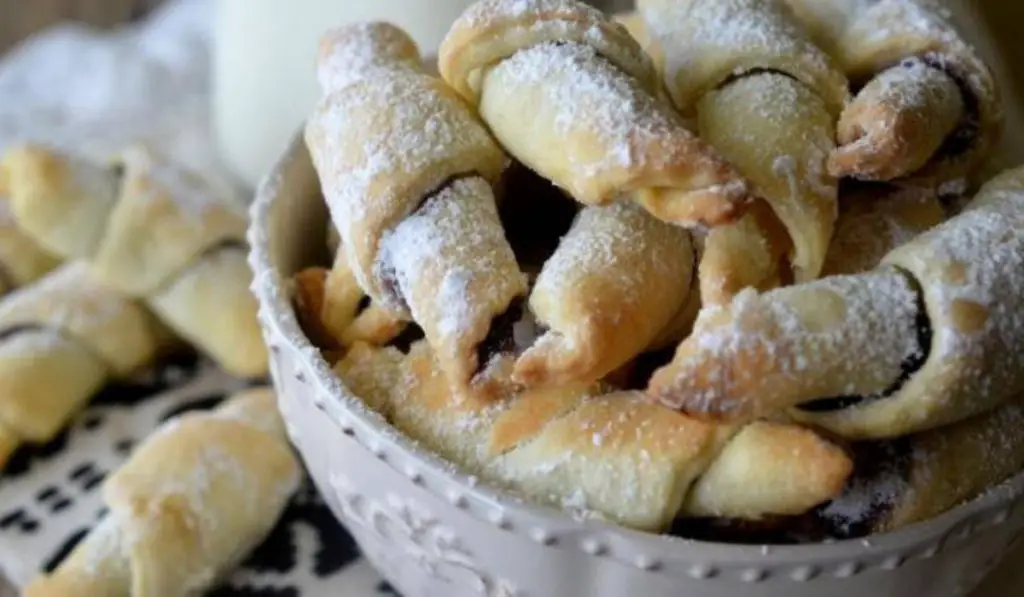
These delicate little cookies are a beloved favorite among Romanians (and visitors!). Rich, buttery cookie dough is twisted around different fillings such as poppy seeds, hazelnuts, or plums. Finished off with a dusting of powdered sugar, be sure to grab a napkin (or be ok with licking your fingers in public).
These crumbling little cookies are like a combination of shortbread, scone, and croissant. The dough is twisted in the shape of croissant after the filling is added.
They are addicting, so be forewarned that you’ll be coming back for more.
vargabéles
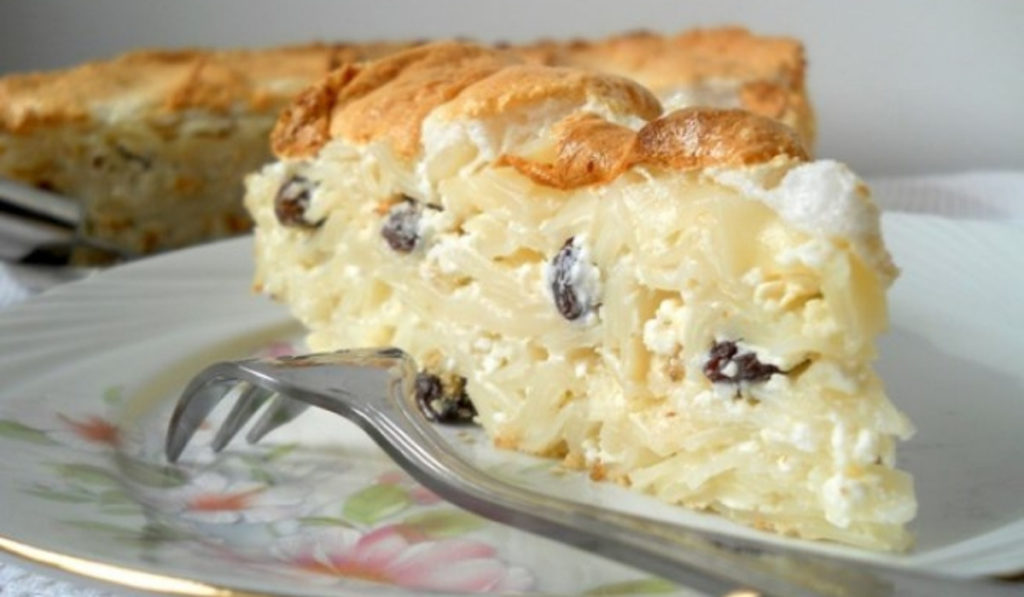
This ‘dessert’ is Hungarian in origin, but you can find it in abundance throughout Transylvania and other places with a large population of ethnic Hungarians. Since it was invented in Cluj-Napoca, where I live, it’s on plenty of menus here.
This is another local dessert that has very subtle flavors. This works well for me – I’m not such a sweet dessert person, and I appreciate the subtleness of Transylvanian desserts.
Personally, this one is not my favorite. And what was even more unusual is that I tried it after originally writing this article. But… not as a dessert! My mother-in-law served it as a meal, which surprised me. So it can be eaten as either, a light dessert or a sweet main meal.
It’s got a consistency similar to rice pudding, only it’s made with Hungarian sweet noodles. This interesting ‘noodle pie’ is made with egg noodles, egg whites, sweet cheese, and milk between fluffy pastry layers. Occasionally you will find it with raisins, lemon zest, whipped cream, or cinnamon added.
placintă
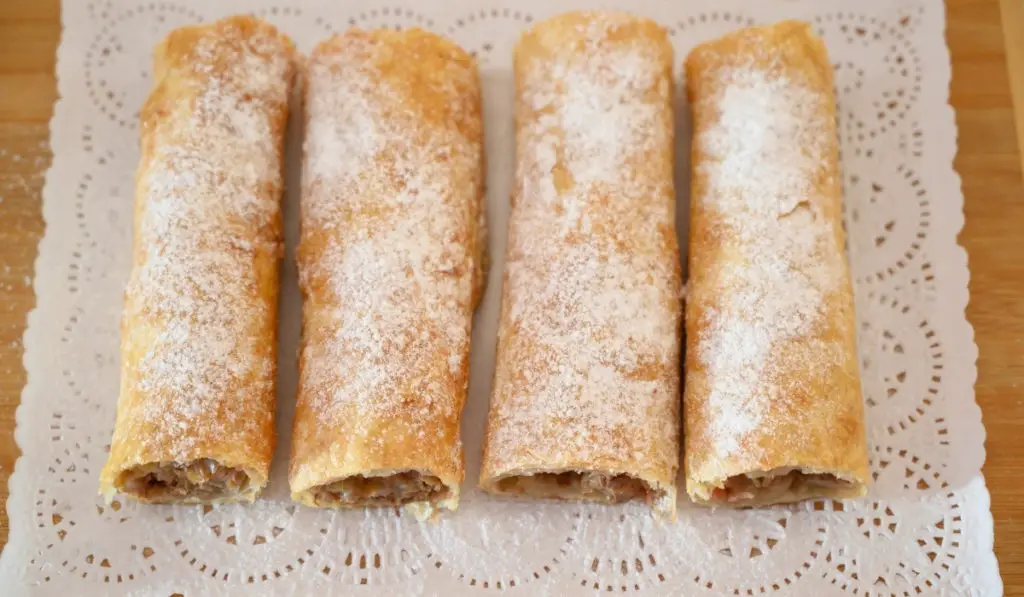
Placintă translates to ‘pie’ in Romanian and you can find many variations of these Romanian desserts with different fillings. Some of them can be made as a layered cake, while some are more like a sponge cake, but all of them have a deliciously creamy filling.
Common variations include chocolate, apricot (caise), apple (mere), branza (cheese), and more. This traditional Romanian food is a staple throughout the country, and something you cannot miss!
papanași

Papanași are undoubtedly the most famous desserts in Romania. Tourists and locals alike swoon over these sumptuous little sweet cheese donuts. They come in varying sizes, from the size of a golf ball to the size of a fist.
You can make papanași either fried or boiled – guess which is better! Obviously the fried ones are the beloved favorites. The boiled donuts are usually coated in a wet breadcrumb and sugar mixture.
If you visit a restaurant in all of Romania that offers dessert, you can be all but guaranteed to see these on the menu. They are best served warm with a fruit or sour plum compote and a dollop of sour cream, finished with a dusting of powdered sugar.
joffre cake
In the 1920s, a French Marshal visited an elite café in Bucharest, Casa Capsa. When the owners learned he would visit, they wanted to make a special cake in his honor, and thus was born the Joffre Cake. It’s Romania’s closest version to a chocolatey, rich dessert.
The cake is special because it’s shaped after the traditional helmets that the French army wore during the time.
Chocolate lovers can rejoice! This is the closest thing to a rich, simple chocolate cake you’ll get in Romania. Made with alternating layers of chocolate buttercream and rich chocolate ganache, this is the epitome of decadent. Finished with a layer of homemade buttercream chocolate frosting and cocoa powder, you’ll be licking your fingers after this one.
I’m not a chocolate lover, but I was a huge fan when my mother-in-law surprised me with this for my birthday one year! It’s traditionally served at birthday parties.
kürtőskalács
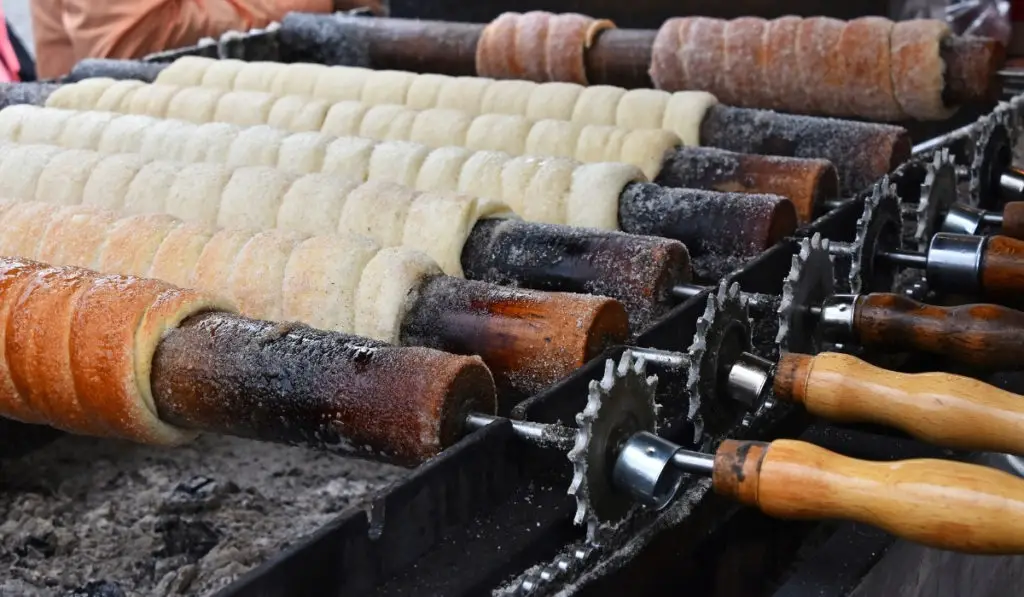
Another dessert that is Hungarian in origin, Kürtőskalács are sometimes referred to as chimney cakes, for the shape they take after they are made. More of a street food than a sit-down dessert, kürtőskalács are spit-roasted cakes that you can often find at a food truck or walk-up window.
The baker spins a flat piece of sweet dough around the spit and coats it in sugar or sugar-cinnamon mixture before roasting it until it’s a gorgeous, brûléed golden brown. The best places to get chimney cakes will consistently baste the dessert with butter while it’s roasting. The outside is perfectly crispy and warm, while the inside remains its fluffy, light doughy texture.
There are different toppings that are available such as ground walnuts, crushed biscuits, powdered sugar, shredded coconut, cinnamon sugar, or cocoa powder. These are best eaten hot and fresh, so try to get one right off the fire.
plăcintă cu urdă
This sweet cheese pie has a mild flavor, like most desserts of the region. Romanians love to use sweet urdă cheese in their desserts, which is somewhat reminiscent of cottage cheese. Urdă, granulated sugar, vanilla extract, and eggs combine to make this surprisingly light and popular dessert.
Occasionally, makers of plăcintă cu urdă will veer from tradition. Because of its simple preparation, it’s easy to get creative with additional ingredients for this pie. Orange zest, vanilla sugar, rum syrup, grated apples, and other various fillings are common variations.
clătite
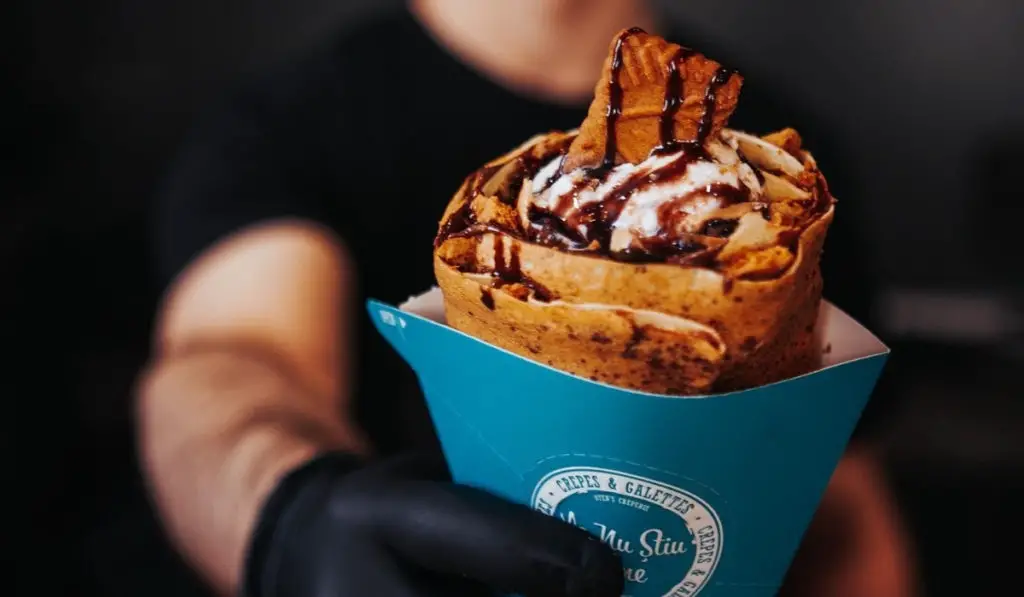
Clătite are a close runner-up for most popular dessert in Romania. They are most similar to French crepes and come in a myriad of fillings. Using a griddle, a thin layer of batter is lightly cooked and then wrapped like a cone. Depending on where you get them, you can get pretty creative with the different fillings and toppings you add.
We love to go to La Nu Stiu Cine in Cluj-Napoca for our clatite. Our friend, a Ukrainian called Ghita, made them for me for an entire summer when I was pregnant and they were all I could eat. With strawberries, bananas, and nutella, or ice cream and chocolate, or strawberries with kiwi and mascarpone – you can’t go wrong.
In restaurants, the toppings are usually more limited to plum preserve, sour cherry, or chocolate.
albinita
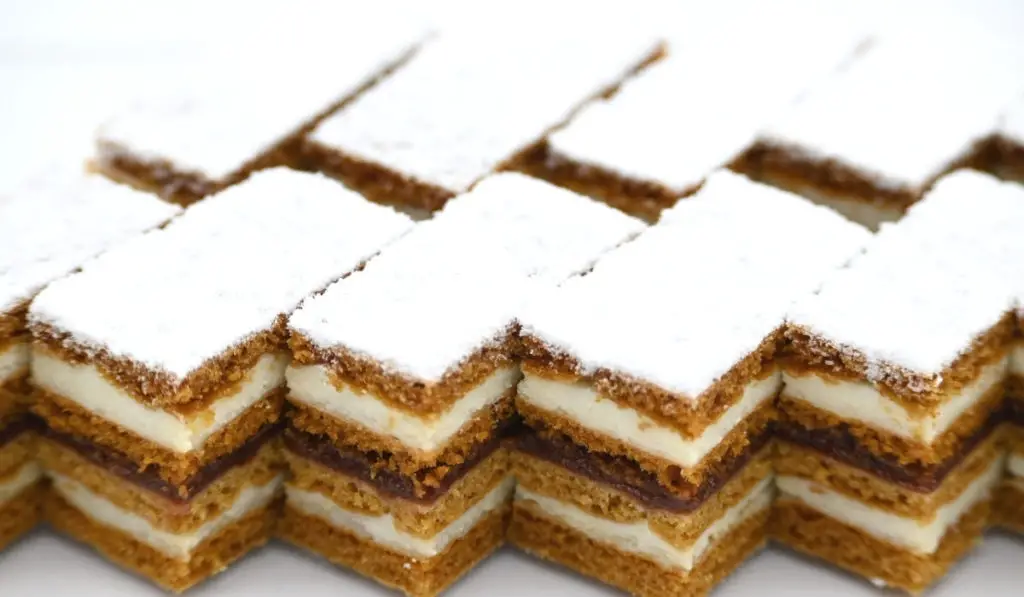
I mentioned earlier that I’m not usually someone who has such a strong sweet tooth. I usually never order dessert and I prefer to have something savory for breakfast. For some reason, all I could eat when I was pregnant were sweet things! And albinita was one of my favorites.
One of the most common Romanian layer cakes, this one translates to ‘little bee’. It is a delicious Romanian honey cake made with many layers of sweet cream, honey, vanilla extract, lemon cream, and apricot jam.
brânzoaică
Another sweet cheese dessert, Brânzoaice are from Moldavia, one of the three regions of Romania. Traditionally prepared with vanilla extract and raisins alongside sweet cheese folded into a flaky square of puff pastry.
The secret to this dessert is the special technique used to fold the dough. You’ll need a traditional Romanian bunică (grandmother) to teach you in order to get it right – similar to sarmale. Neither of which I have learned!
The trick in folding the filo pastry is folding the corners over themselves in such a way that the filling doesn’t seep out of the cracks.
cozonac
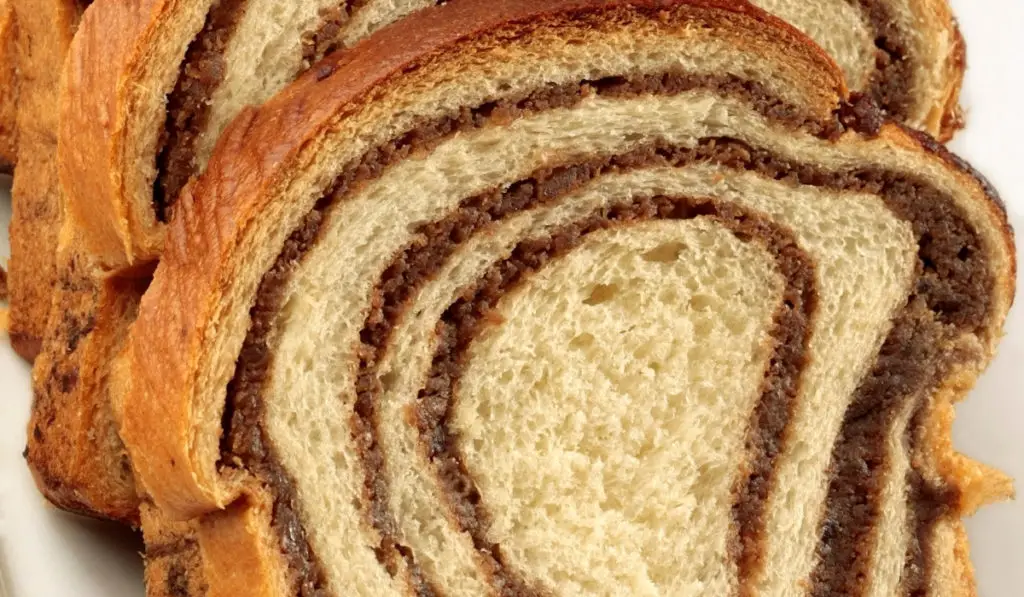
Cozonac is a traditional Balkan dessert that is found in Romania and in nearby countries. It’s a common addition to the table during Christmas dinner, but you can occasionally see it other times throughout the year as well.
Made of a brioche-like sweet bread, you’ll find the mouth watering flavors of melted butter permeate the fluffy marbled cake. As with other Romanian desserts, many times it is made with different variants such as orange peel, vanilla extract, lemon zest, crushed walnuts, turkish delight, coconut flakes, or raisins.
You can eat it warm or served cold with whipping cream – regardless, it’s a delicious cake!
pască
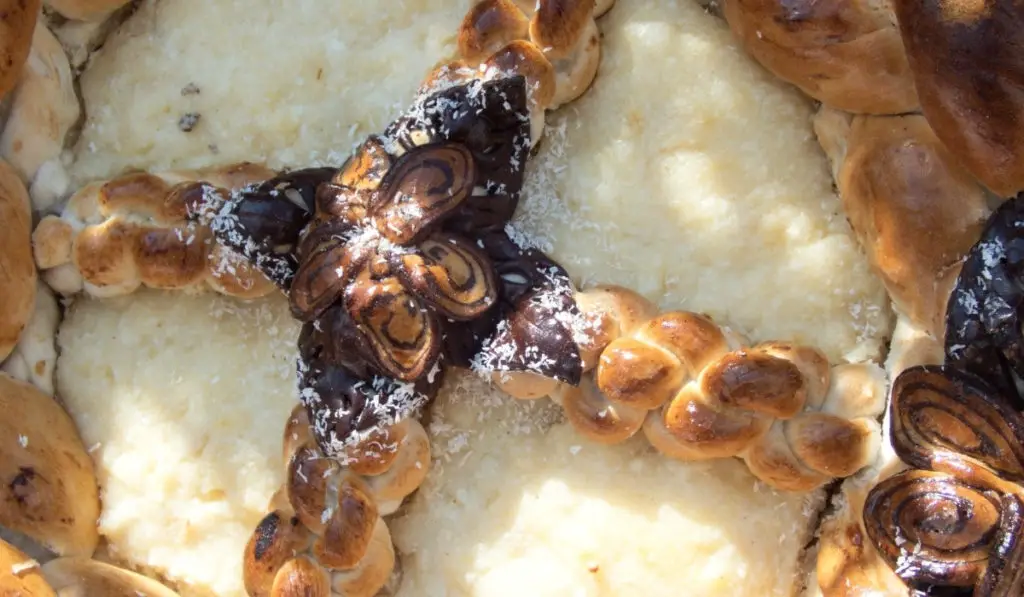
As you may be able to tell by the name, this is a traditional Romanian dessert served around Easter time. Though it uses simple ingredients (that are similar to the main ingredients used in other Romanain desserts), it’s braided into a beautiful circular shape that sets it apart from the rest.
Using sweet cottage cheese, a bit of sour cream, rum-soaked raisins, an aromatic mixture of spices and sweet cake, you can imagine that this is also a very subtle and lightly sweetened dessert.
mucenici
This delicious dessert is made from a sweet dough shaped in a figure eight. After the shapes are made, the dough is left to cook in boiled water with heaps of spices and crushed walnuts, making an incredibly unique and flavorful treat.
These are sometimes called ‘little martyrs’ in English, due to the translation from Romanian. They are named as a tribute to the Forty Martyrs of Sebaste, a group of Christian-Roman soldiers. During the persecutions of Diocletian, the Forty Martyrs refused to stray from their faith and were killed by drowning.
It’s a little macabre, but the boiling water the mucenici are cooked in is meant to be the water the Martyrs drowned in. They aren’t too common in comparison to some of the other delicious desserts on this list, but you might be able to find some on 9 March, when the Forty Martyrs feast is held.
frigănele
Romanians tend to treat this dish as more of a breakfast than a dessert, but it’s sweet, so what the hell? It’s pretty similar to a French Toast or a sweetened pâine în ou. Slabs of sweet bread are drenched in a batter of eggs, powdered milk, and spices with a bit of plum jam and powdered sugar.
Try some simple variations. The traditional Romanian version of many of these desserts tend to be a bit bland due to the country’s history of poverty and food shortages.
găluşte cu prune
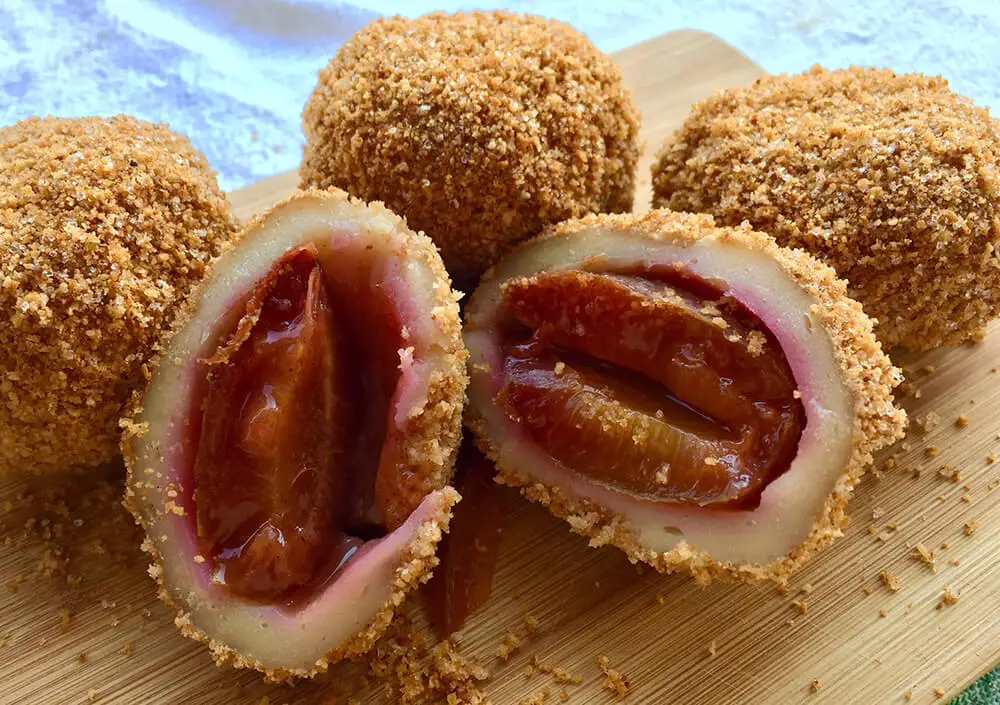
Găluşte cu prune are simple to the boiled version of papanasi, except the filling is with plums instead of sweet cheese. My mother in law makes these all the time, and I get to have them all since my husband doesn’t like them very much. In his defense, I will admit they don’t taste like too much. Another example of a Romanian dessert that can be spruced up a bit with additional ingredients.
These boiled dumplings are similar to gnocchi and usually smaller than papanasi. They are coated in a wet breadcrumb mixture made of cinnamon, sugar, and a little vegetable oil as a binding agent. Ground walnuts are also occasionally used.
Get a little adventurous and drizzle some icing sugar or yellow glaze over your galuste or try a dab of sour cream.
gogoși
While găluşte cu prune are like the boiled version of papanasi, gogoși are like the fried version, made in searing hot oil. The dough is scented with citrus zest and prepared without butter or yeast. The maker adds the dough to the oil by the spoonful, which results in some unusual shapes that are nowhere near uniform.
Sometimes you can find them with a creamy filling, sometimes just plain with a little powdered sugar over the top. These traditional desserts can be found in local bakeries or supermarkets.
carpati
Considering where I live in the Carpathian mountains, I’d be remiss to not include this one on the list, although it’s not too well-known. Carpati is a traditional Romanian dessert that is inspired in the shape of the Carpathian Mountains. With eight layers of sponge cake and chocolate cream, after Joffre Cake, it’s a close second for the top Romanian chocolate cake.
You’ll pretty much never find this in a restaurant, but if you visit a Romanian family’s home for a holiday, you might get lucky!
plăcintă – pie
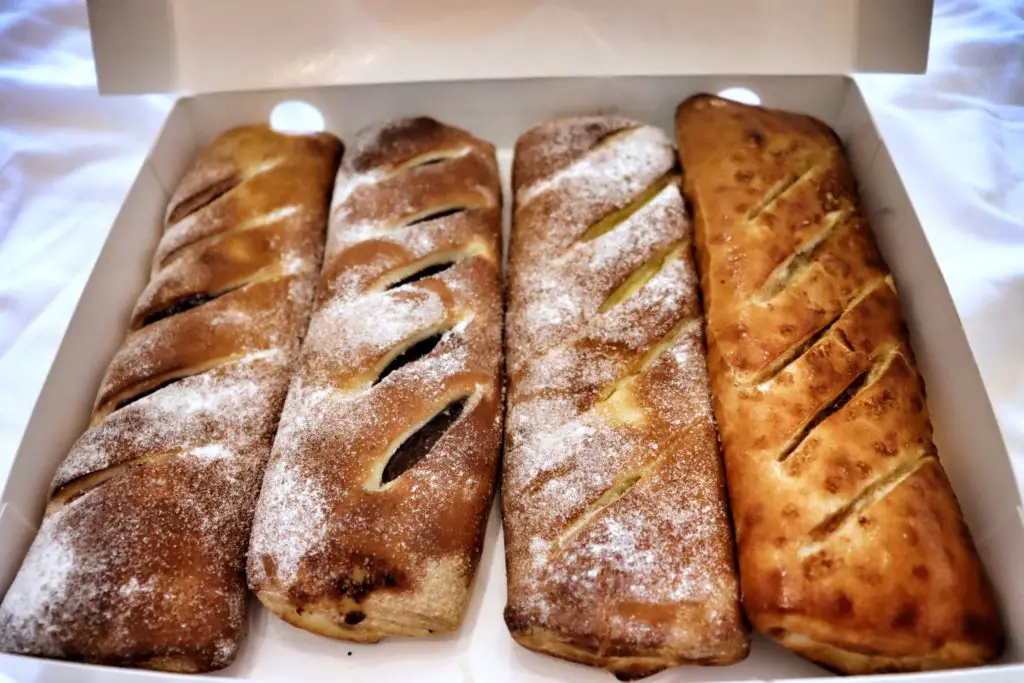
A Romanian pastry most similar to a pie, that consists of different fillings. They are usually round in shape, and many variations of them exist within the Balkans. Pictured above are apple, chocolate, soft cheese, and sour plum.
vegetarian / vegan food in romania
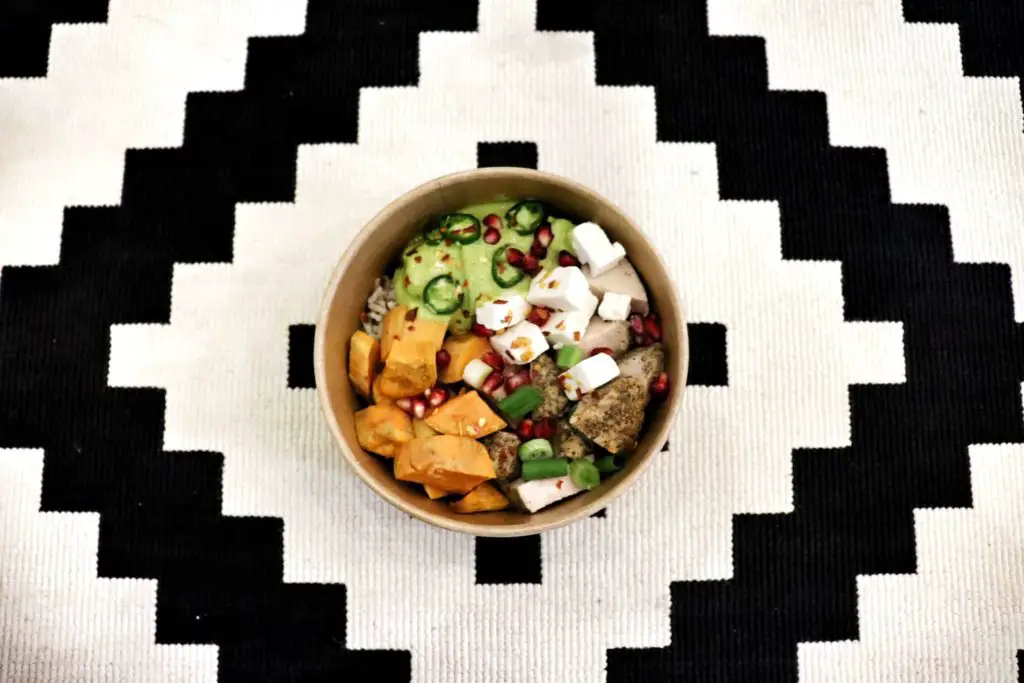
Romania has a surprising amount of vegetarian and vegan food offerings at restaurants. If you’re unsure, or if you need to tell your server, the phrase ‘de post‘ is all you’ll need to know. In the weeks before Easter you’ll have especially good luck, as virtually every restaurant offers vegan dishes for the period of fasting.
You will usually be able to find vegetarian or vegan pastas, pizzas, and salads pretty easily. In terms of traditional Romanian foods, you’ll be safe with zacuscă, salata de vinete, and mămăligă for sure. Often times, Romanian restaurants will offer vegetarian versions of sarmale, tocăniță, and papricaș (usually with mushrooms). These may or may not be vegan friendly, be sure to check with your server.
If you’re vegetarian or vegan and make it to Cluj, be sure to check out Samsara Foodhouse.
pin it
